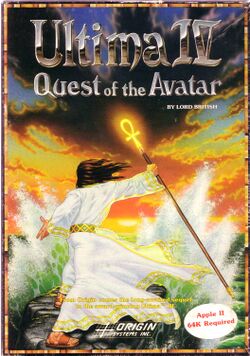
| Ultima IV: Quest of the Avatar | |
|---|---|
| Developer(s) | Origin Systems |
| Publisher(s) | Origin Systems, Sega |
| Year released | 1985 |
| System(s) | Commodore Amiga, Apple II, Atari 8-bit, Atari ST, Commodore 64/128, DOS, FM Towns, NEC PC-8801, Sega Master System, Sharp X1, Sharp X68000 |
| Preceded by | Ultima III: Exodus |
| Followed by | Ultima V: Warriors of Destiny |
| Series | Ultima |
| Designer(s) | Richard Garriott |
|---|---|
| Genre(s) | Role-playing game |
| Modes | Single player |
| Ultima IV: Quest of the Avatar | |
|---|---|
| Developer(s) | Newtopia Planning |
| Publisher(s) | Pony Canyon |
| Year released | 1987 |
| System(s) | NEC PC-9801, MSX2, Fujitsu FM-7 |
| Ultima IV: Quest of the Avatar | |
|---|---|
| Developer(s) | Elite Systems |
| Publisher(s) | Elite Systems |
| Year released | 2013 |
| System(s) | iOS |
- This guide is for the original release. For the NES remake, see Ultima IV: Quest of the Avatar (NES).
Ultima IV: Quest of the Avatar is the fourth in the series of Ultima computer role-playing games. It is the first in the "Age of Enlightenment" trilogy, shifting the series from the hack and slash, dungeon crawl gameplay of its "Age of Darkness" predecessors towards an ethically-nuanced, story-driven approach. Ultima IV is different among role-playing games in that the game's story does not center on asking a player to overcome a tangible ultimate evil.
-
Title (Atari ST)
-
Title (Sega Master System)
Story[edit | edit source]
After the defeat of each of the members of the triad of evil in the previous three Ultima games, the world of Sosaria underwent some radical changes in geography: three quarters of the world disappeared, continents rose and sunk, new cities were built to replace the ones that were lost. Eventually the world, now unified in Lord British's rule, was renamed Britannia. Lord British felt the people lacked purpose after their great struggles against the triad were over, and he was concerned with their spiritual well-being in this unfamiliar new age of relative peace, so he proclaimed the Quest of the Avatar: he needed someone to step forth and become the shining example for others to follow.
Versions[edit | edit source]
Note that the most advanced ports are different from the most popular one.
| Original version | 1985: Apple II |
|---|---|
| Most popular port | 1987: MS-DOS |
| Most advanced ports | 1988: Atari ST (& Amiga)[1] 1990: Master System |
| Remake | 1989: NES |
| Other ports | |
| Fan-made version | 2001: upgrade patch for the MS-DOS port |

